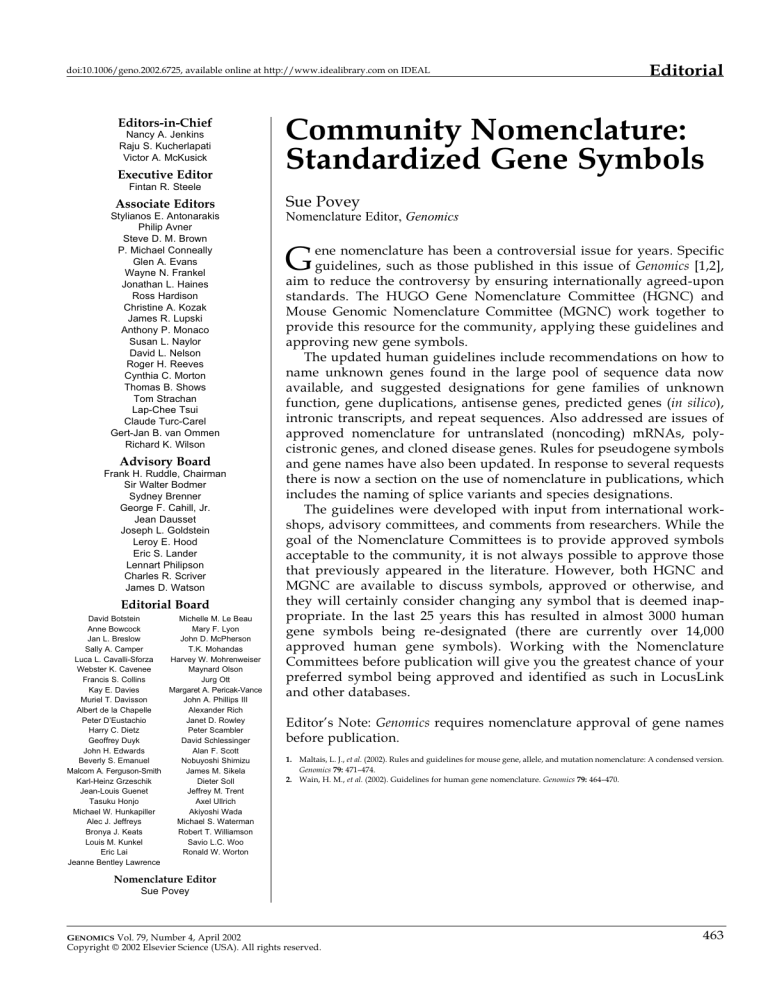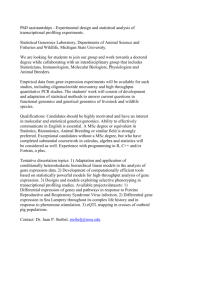
doi:10.1006/geno.2002.6725, available online at http://www.idealibrary.com on IDEAL
Editors-in-Chief
Nancy A. Jenkins
Raju S. Kucherlapati
Victor A. McKusick
Executive Editor
Editorial
Community Nomenclature:
Standardized Gene Symbols
Fintan R. Steele
Associate Editors
Stylianos E. Antonarakis
Philip Avner
Steve D. M. Brown
P. Michael Conneally
Glen A. Evans
Wayne N. Frankel
Jonathan L. Haines
Ross Hardison
Christine A. Kozak
James R. Lupski
Anthony P. Monaco
Susan L. Naylor
David L. Nelson
Roger H. Reeves
Cynthia C. Morton
Thomas B. Shows
Tom Strachan
Lap-Chee Tsui
Claude Turc-Carel
Gert-Jan B. van Ommen
Richard K. Wilson
Advisory Board
Frank H. Ruddle, Chairman
Sir Walter Bodmer
Sydney Brenner
George F. Cahill, Jr.
Jean Dausset
Joseph L. Goldstein
Leroy E. Hood
Eric S. Lander
Lennart Philipson
Charles R. Scriver
James D. Watson
Editorial Board
Michelle M. Le Beau
David Botstein
Mary F. Lyon
Anne Bowcock
John D. McPherson
Jan L. Breslow
T.K. Mohandas
Sally A. Camper
Harvey W. Mohrenweiser
Luca L. Cavalli-Sforza
Maynard Olson
Webster K. Cavenee
Jurg Ott
Francis S. Collins
Margaret A. Pericak-Vance
Kay E. Davies
John A. Phillips III
Muriel T. Davisson
Alexander Rich
Albert de la Chapelle
Janet D. Rowley
Peter D’Eustachio
Peter Scambler
Harry C. Dietz
David Schlessinger
Geoffrey Duyk
Alan F. Scott
John H. Edwards
Nobuyoshi Shimizu
Beverly S. Emanuel
James M. Sikela
Malcom A. Ferguson-Smith
Dieter Soll
Karl-Heinz Grzeschik
Jeffrey M. Trent
Jean-Louis Guenet
Axel Ullrich
Tasuku Honjo
Akiyoshi Wada
Michael W. Hunkapiller
Michael S. Waterman
Alec J. Jeffreys
Robert T. Williamson
Bronya J. Keats
Savio L.C. Woo
Louis M. Kunkel
Ronald W. Worton
Eric Lai
Jeanne Bentley Lawrence
Sue Povey
Nomenclature Editor, Genomics
ene nomenclature has been a controversial issue for years. Specific
guidelines, such as those published in this issue of Genomics [1,2],
aim to reduce the controversy by ensuring internationally agreed-upon
standards. The HUGO Gene Nomenclature Committee (HGNC) and
Mouse Genomic Nomenclature Committee (MGNC) work together to
provide this resource for the community, applying these guidelines and
approving new gene symbols.
The updated human guidelines include recommendations on how to
name unknown genes found in the large pool of sequence data now
available, and suggested designations for gene families of unknown
function, gene duplications, antisense genes, predicted genes (in silico),
intronic transcripts, and repeat sequences. Also addressed are issues of
approved nomenclature for untranslated (noncoding) mRNAs, polycistronic genes, and cloned disease genes. Rules for pseudogene symbols
and gene names have also been updated. In response to several requests
there is now a section on the use of nomenclature in publications, which
includes the naming of splice variants and species designations.
The guidelines were developed with input from international workshops, advisory committees, and comments from researchers. While the
goal of the Nomenclature Committees is to provide approved symbols
acceptable to the community, it is not always possible to approve those
that previously appeared in the literature. However, both HGNC and
MGNC are available to discuss symbols, approved or otherwise, and
they will certainly consider changing any symbol that is deemed inappropriate. In the last 25 years this has resulted in almost 3000 human
gene symbols being re-designated (there are currently over 14,000
approved human gene symbols). Working with the Nomenclature
Committees before publication will give you the greatest chance of your
preferred symbol being approved and identified as such in LocusLink
and other databases.
G
Editor’s Note: Genomics requires nomenclature approval of gene names
before publication.
1. Maltais, L. J., et al. (2002). Rules and guidelines for mouse gene, allele, and mutation nomenclature: A condensed version.
Genomics 79: 471–474.
2. Wain, H. M., et al. (2002). Guidelines for human gene nomenclature. Genomics 79: 464–470.
Nomenclature Editor
Sue Povey
GENOMICS Vol. 79, Number 4, April 2002
Copyright © 2002 Elsevier Science (USA). All rights reserved.
463



